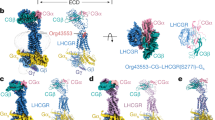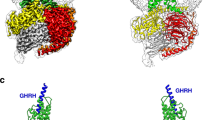Abstract
The glycoprotein hormone receptors—luteinizing hormone receptor (LHR), follicle-stimulating hormone receptor (FSHR), and thyroid-stimulating hormone receptor (TSHR)—are G-protein-coupled receptors with an invariant 10-amino acid residue sequence in the ectodomain proximal to transmembrane helix 1. A Glu-ASP, located at the midpoint of this conserved sequence, has been suggested to be important in ligand-mediated signaling of LHR and/or receptor expression or stability, but not binding. One goal of this study was to expand the studies on LHR and determine whether the invariant Glu and Asp residues were functional in FSHR and TSHR as well. Another goal was to investigate systematically the role of ionic strength, particularly Na+, which appears to have enigmatic functions in the three receptors regarding ligand binding and receptor activation, and to ascertain whether any of the purported effects of Na+ could involve the conserved pair of acidic side chains in the ectodomain. COS-7 cells were transiently transfected with cDNAs to the wild-type (WT) receptor (rat) and identical single and double mutants of each (Glu→Ala, Asp; Asp→Ala, Glu; and Glu-Asp→Asp-Glu), followed by characterization of cognate ligand binding and signaling (basal and hormone mediated) in two commonly used buffer systems: Waymouth’s medium, containing a near-physiologic concentration of Na+ (132 mM); a low ionic strength buffer with a 1 mM concentration of Na+. The three receptors exhibited differential responses to mutagenesis and the two buffers. Notably, a comparison of basal cyclic adenosine monophosphate (cAMP) production showed that the buffer of lower ionic strength resulted in increased basal cAMP production in WT TSHR but not LHR and FSHR; that the maximal ligand-mediated cAMP production was greatest in the buffer of higher ionic strength for the three WT receptors; that functionality of the conserved Glu and Asp residues in ligand-mediated signaling was buffer dependent in LHR, whereas it did not appear to be particularly important in FSHR and TSHR signaling; and that apparent ligand binding in WT and mutant TSHRs seemed to be particularly diminished in the buffer of higher ionic strength. These results demonstrate that identical amino acid residues in homologous receptors can exhibit distinct functions; moreover, the role of ionic strength (Na+) on signaling differs in the three receptors.
Similar content being viewed by others
References
Huang, J. and Puett, D. (1995). J. Biol. Chem. 270, 30023–30028.
Alvarez, C. A., Narayan, P., Huang, J., and Puett, D. (1999). Endocrinology 140, 1775–1782.
Stavrou, S. S., Zhu, Y.-S., Cai, L.-Q., et al. (1998). J. Clin. Endocrinol. Metab. 83, 2091–2098.
Parma, J., Duprez, L., Van Sande, J., et al. (1993). Nature 365, 649–651.
Kosugi, S. and Mori, T. (1994). FEBS Lett. 341, 162–166.
Cetani, F., Tonacchera, M., and Vassart, G. (1996). FEBS Lett. 378, 27–31.
Combarnous, Y., Guillou, F., and Martinat, N. (1986). J. Biol. Chem. 261, 6868–6871.
Buettner, K. and Ascoli, M. (1984). J. Biol. Chem. 259, 15078–15084.
Quintana, J., Wang, H., and Ascoli, M. (1993). Mol. Endocrinol. 7, 767–775.
Tate, R. L., Holmes, J. M., Kohn, L. D., and Winard, R. J. (1975). J. Biol. Chem. 250, 6527–6533.
Andersen, T. T. and Reichert, L. E. Jr. (1982). J. Biol. Chem. 257, 11551–11557.
Tramontano, D. and Ingbar, S. H. (1986). Endocrinology 118, 1945–1951.
Goffenbeig, S. I. and Shravlev, I. V. (1988). Biokhimiia 53, 1214–1219.
Joshi, L. R. and Katz, M. S. (1988). Second Messengers Phosphoproteins 12, 105–121.
Motulsky, H. J. and Insel, P. A. (1983). J. Biol. Chem. 258, 3913–3919.
Limbird, L. E., Speck, J. L., and Smith, S. K. (1982). Mol. Pharmacol. 21, 609–617.
Puttfarcken, P., Werling, L. L., Brown, S. R., Cote, T. E., and Cox, B. M. (1986). Mol. Pharmacol. 30, 81–90.
Vogel, R., Fran, G. B., Sheves, M., and Siebert, F. (2001). Biochemistry 40, 483–493.
Vogel, R. and Siebert, F. (2002). Biochemistry 41, 3536–3545.
Duprez, L., Parma, J., Costagliola, S., et al. (1997). FEBS Lett. 409, 469–474.
Zhang, M., Tong, K. P. T., Fremont, V., et al. (2000). Endocrinology 141, 3514–3517.
Author information
Authors and Affiliations
Corresponding author
Rights and permissions
About this article
Cite this article
Angelova, K., Puett, D. Differential responses of an invariant region in the ectodomain of three glycoprotein hormone receptors to mutagenesis and assay conditions. Endocr 19, 147–154 (2002). https://doi.org/10.1385/ENDO:19:2:147
Received:
Revised:
Accepted:
Issue Date:
DOI: https://doi.org/10.1385/ENDO:19:2:147




